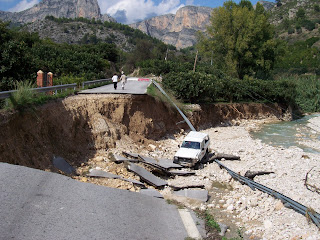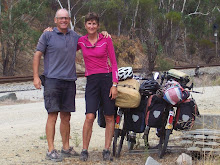The Campsite Iris at
Yverdon-Les-Bains is beside a small harbour. There is a comprehensive electronic weather display which tells us the N.E. wind is 25km/hr, a force 4 on the Beaufort scale, a 'jolie brise'. We wash our clothes in the campsite washing machine & the 'brise' dries it very quickly. The choppy lake has driven a variety of fowl into the harbour, lots of swans, great crested grebes, tufted ducks & a mallard with her chicks. We notice here, as in other Swiss towns & villages, the school mini-buses double as Post vans. Wandering around looking at several restaurants, there are a variety of fondues advertised, including 'de cheval'. We enter the blog using a computer at the very helpful local library.
Along the S. side of
Lac Neuchatel there is firstly a large reed bed bird reserve, then lots of small wooden chalet summer residences & little yacht clubs & boat parks. The well-signed cycle route is very peaceful, passing through woods, country lanes & villages.
Estavayer-le-Lac, a quaint walled town, is holding a religious festival. They have strewn mown grass over the cobbled streets leading from the town gates to the church. Children are carrying posies of wild flowers, & the youth band is smart in a blue uniform - all rather subdued & organised in comparison with Spanish frenetic celebrations!
At the E. end of Lac Neuchatel we camp in a very smart site with a view of the lake from our tent. We offload our gear to cycle round to the N. side to the handsome town of
Neuchatel, full of cobbled squares, painted fountains & a lot of posh shops. We have now moved into the german speaking part of Switzerland, but as we are not up to a third foreign language, they have to put up with our French.
In lovely weather the following day, we continue on National Cycle Route 5 along the S. side of the next lake,
Biele See. Picture-postcard villages are full of timber-clad farms & houses with enormous steep-pitched roofs, & piles of logs for the winter. We pass several parties of teenage children, all on bikes, following their teachers.
Buren-am-Aare has a wooden bridge enclosed on the sides & covered with a pitched-tiled roof. We are to see several more just like this, & suppose it means the river crossing are kept open when the snows come. We camp at
Solothun on the
Aare river, Switzerlands biggest river, it is about 100m across here & very swift flowing. Again this is a beautiful waterside site, the 3rd TCS (Touring Cycle Suisse) site we have stayed on. Whilst here, we at last see a live red squirrel, it nearly runs over our feet! In nearby fields, we see the first storks since Spain, as they & Red Kites follow the working plough. The storks nest in trees here, not on buildings. There is a very helpful cycle repair shop in Solothun called Tropical, which fit Mike's bike with a new set of Schwalbe Marathon Plus tyres.
We head S.E. towards the middle of Switzerland now, passed immaculate timber farms with flower boxes & painted verandas. We cross lots of level crossings, as the train lines continue to serve lots of local stations. As we approach
Sempacher See there are fabulous views of the Alps to the S., extremely jagged & snow-covered. The cycle route takes us past this small lake to
Lucerne, & its lake. What a lovely city, with 2 covered wooden bridges, & 2 ornate filigree iron ones. The old centre of cobbled streets with mural-decorated houses & hotels is a delight. There are literally thousands of bikes parked, or being used around the city. This is the prettiest lake yet, & following the quiet S. shore, we have terrific views across to jagged snowy peaks. A big paddle steamer & a few sailing boats make the scene picture-perfect. Outside some houses we notice Christmas trees decorated with glittery streamers. These are to celebrate the recent birth of a child. We stop at yet another lovely TCS site right on the Lake edge near the cycle path at
Horw. Dominating the scene is snowy
Pilatus Mountain at 2,050m. This has a dramatic cable car to the very top.
We have now completed 4,000 miles since we left Santander last September, & 2,200 since we left Nerja in April. No wonder Mike needs new tyres! As the weather is good here at present, we may stay on the Lake for a few days, cycling & walking, before heading N.E. towards Bodensee to pick up the Rhine.
We spend the next day cycling around most of the Lake, 41 miles. We miss out the far east corner as the cycle route takes us on the ferry here, & it ids a great opportunity for a boat trip on the Lake.








































